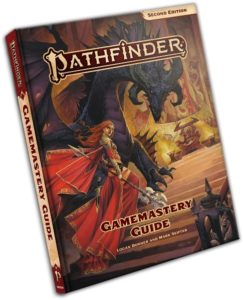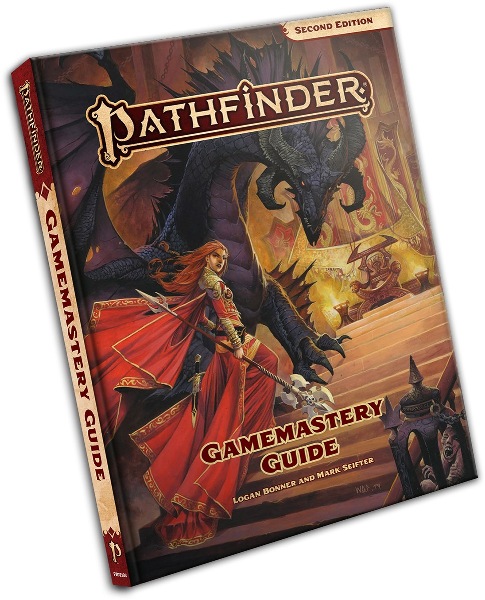
Gamemastery Guide
Gamemastery Guide is a core supplement for the epic fantasy Pathfinder Second Edition, written by Logan Bonner and Mark Seifter and published by Paizo.
By Aaron T. Huss

Learn more about Gamemastery Guide here
Purchase Gamemastery Guide here (paid link)
Find other Pathfinder Second Edition posts here
Gamemastery Guide is one of the staple core supplements for Pathfinder, and Second Edition is no different. It is the ultimate guide for the homebrew GM or the GM that needs a little assistance running a published module. The book is broken into four mechanical categories with a fifth bonus section covering ready-made NPC stat blocks. The first category covers all the basic aspects of what it means to be a GM, the second is a series of tool kits that provide additional guidance for building your own games, the third is a collection of subsystems that add optional layers to the game for running very specific types of conflict resolution, and the fourth is a set of variant rules for rules that already exist (some are alternates, some are more of an expansion of the existing). The bonus section is a huge collection of templates covering a plethora of character types for quick insertion into a game.
Gamemastery Guide is really a scaled supplement that provides an incredible amount of value in a myriad of ways. The first level discusses what it means to be a GM and all the nuances that come with it. This includes advice on running encounters, exploration, and downtime; it discusses why and how the GM adjudicates the rules, making it his or her game or finding a way to roll with what the players are throwing down; it includes a number of specialty situations including narrative collaboration, rarity, and dealing with oddities in your game; finally, it delves into how you would create encounters, adventures, and campaigns. All of this is effectively a sliding scale of GM comfort from the newbie to the veteran looking to venture off and creating a campaign of their own for a change.
The second level of this scaling book gets into the mechanical design of creating games. This is great for the homebrew GM, but it’s actually also incredibly valuable for the developer, editor, and publisher of Pathfinder Second Edition content. It’s like buying a car and the engineer comes over and shows you how they designed it just in case you want to design your own. This is literally a behind-the-scenes look at how everything fits together in Pathfinder mechanically, because Pathfinder is a very mechanical game. This includes how-to guides for creatures, hazards, items (including intelligent and cursed), relics, artifacts, worlds, and various types of locales. It is a one-stop shop for the designer GM and is probably my favorite section of the entire book. But that’s mainly because I love understanding how developers build their games and how they balance them.
The third level is for the GM looking to take things beyond the standard conflict resolution methods presented in the core rulebook. They call them subsystems and most of them are points-based, extended resolution methods. Sometimes a conflict cannot be resolved by a single dice roll, but using a simple extended resolution template is simply too boring in this very mechanical system. Instead, you are presented with a number of similar, but slightly different, resolutions methods of things like influence, research, chases, infiltration, duels, and more. These are pretty cool; I like the depth each one goes into, but I think they could have simplified it into categorical subsystems and combine the resolution reasons. Not all of them, of course, as some of them cannot be grouped categorically. However, if you have a character-to-character extended conflict, they could all be theoretically resolved using the same set of mechanics. But oh well; these subsystems are still fun to incorporate when in the hands of a learned GM.
The fourth level is really my least favorite covering variant rules. It’s not that I dislike variant rules, I just think their execution could be improved. For example, there is a variant on alignment that adds these gray areas between the existing alignments. Yeah, not really necessary and I don’t see that getting much use. Maybe it would be better to add some depth to alignment such as making them more three-dimensional instead of using a 2-dimensional scale. To me that would be more fun to play with. Another example is how they didn’t really capture the essence of running Level 0 characters. This one-page depiction is definitely lacking. I do like their creation of adding Stamina as another layer of health, but otherwise I think this section could have been developed better. Maybe fewer variants, but with more depth would have been a better idea.
The bonus has to do with the quick-reacting GM who needs an NPC in a pinch. This is actually really cool is it presents a huge collection of character types – burglar, priest, guide, farmer, etc. – and a full stat block to go with it. All the characters are humans, but there are mechanics on how to change them to elf, dwarf, etc. I don’t think I would have called it an NPC Gallery, but then what else would you call it? Don’t expect fully-fleshed-out NPCs though; these are just mechanical frameworks for you to start from. You still have to add the name, background, and a bit of other pieces to bring the character to life.
Pathfinder is a very mathematical game. Everything is built along this sliding scale of mechanics that follow a character through his or her career, making this progressively more difficult to achiever greater victories. If you only want to run published adventures and campaigns, you’ll never need to worry about the nuances of how the game is created mechanically. If you want to create your own encounters, adventure, campaigns, items, or adversaries, you’ll need to understand how to do it correctly, otherwise you’ll creation risks being overpowered or underpowered. If that’s you, then you should pick-up Gamemastery Guide and consume it all. You’ll probably be thankful you did. If you only run published material or are so veteran to the system that you know it like the back of your hand, you probably won’t need this book, but those ready-made NPCs are great to have in your back pocket… just saying.

